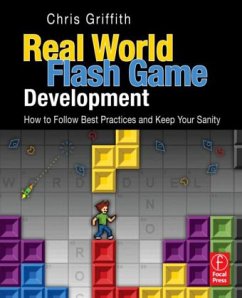This book covers Flash for the everyday developer. The average Flash developer doesn't have luxurious timelines, employers who understand the value of reusability, or the help of an information architect to design a usable experience. This book helps bridge the gap for these coders who may be used to C++, Java, or Csharp and want to move over to Flash. Griffith covers real-world scenarios pulled from his own experiences developing games for over 8 years in the industry.
Gifts from Griffith's REAL-WORLD experiences include: Game design templates and pre-written scripts to automate tasks within Flash; Classes for handling common math computations used in gaming, so that game developers can see how to set up a simple game flow; Powerful debugging tools for your games(debuggers for Flash games are hard to come by, and this book provides them for you).
The associated web site offers: Code from the game examples in the book with fully build-able source files. Additional code snippets, classes, and utilities. Scripts for automating tedious and repetitive tasks within Flash. Template game-design documents for planning game proposals in the same manner outlined in the book. Links to other helpful online resources for both Flash and game development.
Teaches Flash users the most effective ways to leverage Flash as a game development tool. Concrete, relatable approaches to Flash game development.
Provides sound strategies, and realistic goals for success - with REAL-WORLD examples and code included so that programmers become quickly empowered to make their own Flash games.
Covers ALL the aspects that come into play when developing a game in Flash, including art, animation, scripting, and optimization.
Gifts from Griffith's REAL-WORLD experiences include: Game design templates and pre-written scripts to automate tasks within Flash; Classes for handling common math computations used in gaming, so that game developers can see how to set up a simple game flow; Powerful debugging tools for your games(debuggers for Flash games are hard to come by, and this book provides them for you).
The associated web site offers: Code from the game examples in the book with fully build-able source files. Additional code snippets, classes, and utilities. Scripts for automating tedious and repetitive tasks within Flash. Template game-design documents for planning game proposals in the same manner outlined in the book. Links to other helpful online resources for both Flash and game development.
Teaches Flash users the most effective ways to leverage Flash as a game development tool. Concrete, relatable approaches to Flash game development.
Provides sound strategies, and realistic goals for success - with REAL-WORLD examples and code included so that programmers become quickly empowered to make their own Flash games.
Covers ALL the aspects that come into play when developing a game in Flash, including art, animation, scripting, and optimization.
"The volume's 16 chapters (and 3 online bonus chapters) in this new edition (1st ed., 2010) provide a series of discrete challenges: animation, audio and video management, implementing mathematical functions, collision detection, game physics, and creating platformers and iOS games, which gradually build user competence and confidence. Although the examples increase in complexity as the book progresses, it is not necessary to do them in order. The book could be used as a course resource for advanced undergraduates or as a reference for experienced programmers who want t o use Flash. The excellent companion website supplies all the code needed to build the examples, as well as a forum where questions can be posted and answered. The author frequently inserts commentary about best programming practices (what to do and what to avoid), which differentiates this book from many similar titles."
--E. Bertozzi, Long Island University
--E. Bertozzi, Long Island University

